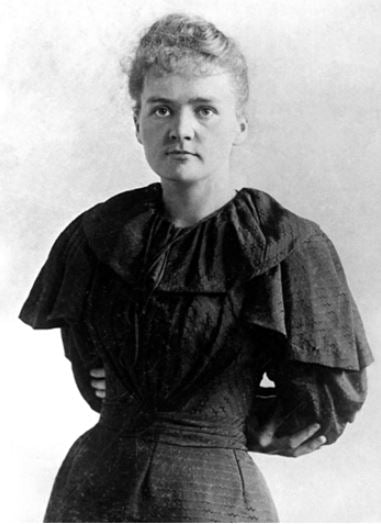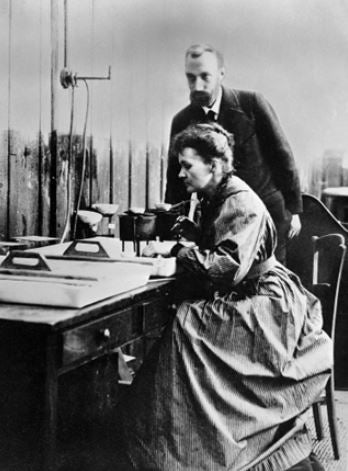Theme: Marie Curie (1867 - 1934)
Let's talk about our Marie theme, which covers the topic of the great chemist Marie Curie and her influential work in radioactivity.

The woman of distinction
For all of her achievements, Marie Curie was held in high esteem and admiration by scientists throughout the world. This was reflected in the numerous awards bestowed on her.
Together with her husband, she received the Nobel Prize for Physics in 1903, for their study into the spontaneous radiation discovered by Becquerel. A few years later, in 1911, she received a second Nobel Prize, this time in Chemistry, in recognition of the discovery of the elements Radium and Polonium.
Marie Curie was the first person to win a Nobel Prize in both physics and chemistry. In fact, she is the only person ever to have won two Nobel Prizes in two different scientific fields.
She also received in 1903, jointly with her husband Pierre Curie, the Davy Medal of the Royal Society. Marie Curie received many honorary science, medicine, and law degrees and honorary memberships from learned societies throughout the world.
She was a member of the Conseil du Physique Solvay from 1911 until her death and also a member of the Committee of Intellectual Co-operation of the League of Nations.

The life of Marie Curie
Maria Salomea Sklodowska was born in Warsaw, Poland on November 7, 1867. She was the youngest of five children and both her parents were educators.
Her father was a secondary-school teacher who taught math and physics. Her mother was a headmistress of a girls-only private school. Both of them strongly believed in education and encouraged Marie’s interest in science.
At age 10, Curie attended boarding school and was moved to a gymnasium, a selective school of sorts destined only for academically strong students. At 15 years old, Marie Curie graduated high school with distinction, earning a gold medal for being the top student.
Marie Curie was passionate about her studies and wanted to continue learning. However, superior education wasn’t available for women in Poland, and her father wasn’t financially able to support her ambition to go to university. Determined to overcome all obstacles, Marie spent the following years working hard to save as much money as she could, while still studying chemistry, physics, and mathematics textbooks throughout the evenings.
In November 1891, aged 24, Marie was finally able to move to Paris where she attended The Sorbonne, also known as University of Paris, Paris’s most prestigious university. There she studied and obtained Licenciateships chemistry, mathematics, and physics.
Three years later, Marie met Pierre Curie, a Professor at the School of Physics, to whom she married and became colleagues with, in what would be the revolutionary field of radioactivity.
Revolution of Radioactivity
At the time, scientists knew that everything in nature is made up of elements. These are materials that can’t be broken down into other substances, like gold, uranium, and oxygen. Today, 118 elements have been identified, but when Marie was born, there were only 63 known elements.
After the discovery of X-rays by Wilhelm Roentgen in 1895, followed by the discovery of what would be known as radioactivity by Henri Becquerel in 1896, Marie and her husband were inspired to further investigate this phenomenon.
They began testing various kinds of natural materials for signs of radioactivity. One substance was a mineral called “pitchblende”, now known as uraninite which scientists believed was made up mainly of oxygen and uranium. The couple found that the mineral pitchblende was more radioactive than uranium and concluded that it must contain other radioactive substances. They decided to hunt for the new element they suspected might be present in the material and ended up discovering two!
The first one called Polonium was named by Marie to honor her homeland. It was found 300 times more radioactive than uranium. The second element was called Radium, from the Latin word for “ray”. Radium was found to be several million times more radioactive than uranium.
They discovered that Radium was a source of heat with luminous compounds. It is always hotter than its surroundings. Together, Marie and Pierre decided to name this phenomenon and coined the term “Radioactivity”.
Curie was able to develop specific techniques that allowed her to separate radium from other radioactive residues so that she could characterize it and study its properties. She was particularly interested in its therapeutic properties. Unfortunately, she was never able to isolate Polonium.
Marie Curie actively promoted the use of radium to diminish suffering. In fact, with the help of her daughter Irene, she devoted herself to this remedial work during World War I. She eventually established a laboratory dedicated to radioactivity in her native city.
Her work is immortalized in many papers published in numerous scientific journals and her books: Recherches sur les Substances Radioactives (1904), L’Isotopie et les Éléments Isotopes and Traité’ de Radioactivité (1910).
